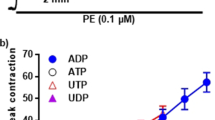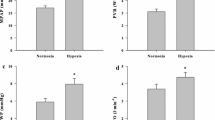Abstract
This study characterizes the relaxant response to 5-hydroxytryptamine (5-HT) in prostaglandin F2α (PGF2α)-precontracted pulmonary arteries of weaned pigs. In arterial rings with intact endothelium, the relaxation to 5-HT was biphasic. The high affinity component of relaxation to 5-HT (0.1–10 nM) was abolished by mechanical removal of the endothelium or after the addition of l-NAME (200 μM), and was inhibited by the 5-HT2B/2C receptor antagonist SB 206553 (1 μM), but not the 5-HT2C receptor antagonist SB 242084 (0.1 μM). Endothelium-intact arteries were also relaxed by the selective 5-HT2B receptor agonist BW 723C86 (pD2 7.7). The relaxant response to BW 723C86 was inhibited by 1 μM SB 206553 (pKB 6.8). The low affinity component of relaxation to 5-HT (≥30 nM) remained unaffected after mechanical removal of the endothelium or the addition of l-NAME. In endothelium-denuded arterial rings, 5-HT, 5-carboxamidotryptamine (5-CT), 5-methoxytryptamine (5-MeOT), and frovatriptan produced monophasic relaxations with pD2 values of 6.5, 7.5, 5.9, and 4.7 respectively. Relaxant responses to the agonists were antagonized by the selective 5-HT7 receptor antagonist SB 269970 (pKB 8.2–8.9). The relaxant response to the potent 5-HT7 receptor agonist 5-CT was also antagonized by methiothepin (pKB 9.6), pimozide (pKB 8.2), mesulergine (pKB 7.7), methysergide (pKB 7.4), clozapine (pKB 7.6), and spiperone (pKB 7.4). The estimated pKB values argue in favor of an involvement of 5-HT7 receptors in the direct vasorelaxant action of 5-HT in the pulmonary arteries of weaned pigs. The relaxant response to 5-CT was associated with an increase in cAMP that was surmountably antagonized by SB 269970 (pKB 8.6). The present in vitro bioassay can be used to characterize new drugs with potential agonist or antagonist properties at functional 5-HT7 receptors.








Similar content being viewed by others
References
Arunlakshana O, Schild HO (1959) Some quantitative uses of drug antagonists. Br J Pharmacol 14:48–58
Baxter GS (1996) Novel discriminatory ligands for 5-HT2B receptors. Behav Brain Res 73:149–152
Bhalla P, Saxena PR, Sharma HS (2002) Molecular cloning and tissue distribution of mRNA encoding porcine 5-HT7 receptor and its comparison with the structure of other species. Mol Cell Biochem 238:81–88
Bromidge SM, Duckworth M, Forbes IT, Ham P, King FD, Thewlis KM, Blaney FE, Naylor CB, Blackburn TP, Kennett GA, Wood MD, Clarke SE (1997) 6-Chloro-5-methyl-1-[[2-[(2-methyl-3-pyridyl)oxy]-5-pyridyl]carbamoyl]- indoline (SB-242084): the first selective and brain penetrant 5-HT2C receptor antagonist. J Med Chem 40:3494–3496
Comer MB (2002) Pharmacology of the selective 5-HT1B/1D agonist frovatriptan. Headache 42 [Suppl 2]:S47–S53
Cushing DJ, Zgombick JM, Nelson DL, Cohen ML (1996) LY215840, a high-affinity 5-HT7 receptor ligand, blocks serotonin-induced relaxation in canine coronary artery. J Pharmacol Exp Ther 277:1560–1566
Eglen RM, Jasper JR, Chang DJ, Martin GR (1997) The 5-HT7 receptor: orphan found. Trends Pharmacol Sci 18:104–107
Ellis ES, Byrne C, Murphy OE, Tilford NS, Baxter GS (1995) Mediation by 5-hydroxytryptamine2B receptors of endothelium-dependent relaxation in rat jugular vein. Br J Pharmacol 114:400–404
Forbes IT, Ham P, Booth DH, Martin RT, Thompson M, Baxter GS, Blackburn TP, Glen A, Kennett GA, Wood MD (1995) 5-Methyl-1-(3-pyridylcarbamoyl)-1,2,3,5-tetrahydropyrrolo[2,3-f]indole: a novel 5-HT2C/5-HT2B receptor antagonist with improved affinity, selectivity, and oral activity. J Med Chem 38:2524–2530
Furchgott RF (1972) The classification of adrenoceptors (adrenergic receptors). An evaluation from the standpoint of receptor theory. In: Blaschko H, Muscholl E (eds) Catecholamines, handbook of experimental pharmacology, vol 33. Springer, Berlin Heidelberg New York, pp 283–335
Glusa E, Pertz HH (2000) Further evidence that 5-HT-induced relaxation of pig pulmonary artery is mediated by endothelial 5-HT2B receptors. Br J Pharmacol 130:692–698
Glusa E, Richter M (1993) Endothelium-dependent relaxation of porcine pulmonary arteries via 5-HT1C-like receptors. Naunyn-Schmiedebergs Arch Pharmacol 347:471–477
Glusa E, Roos A (1996) Endothelial 5-HT receptors mediate relaxation of porcine pulmonary arteries in response to ergotamine and dihydroergotamine. Br J Pharmacol 119:330–334
Grayson KL, Gupta P (1995) Preliminary characterization of an endothelial 5-HT receptor which mediates relaxation in a preparation of dog isolated vena cava. Br J Pharmacol 106:703–709
Gupta P (1992) An endothelial 5-HT receptor that mediates relaxation in guinea-pig isolated jugular vein resembles the 5-HT1D subtype. Br J Pharmacol 106:703–709
Hagan JJ, Price GW, Jeffrey P, Deeks NJ, Stean T, Piper D, Smth MI, Upton N, Medhurst AD, Middlemiss DN, Riley GJ, Lovell PJ, Bromidge SM, Thomas DR (2000) Characterization of SB-269970-A, a selective 5-HT(7) receptor antagonist. Br J Pharmacol 130:539–548
Hoyer D, Boddeke HWGM (1993) Partial agonists, full agonists, antagonists: dilemmas of definition. Trends Pharmacol Sci 14:270–275
Hoyer D, Martin GR (1996) Classification and nomenclature of 5-HT receptors: a comment on current issues. Behav Brain Res 73:263–268
Hoyer D, Hannon JP, Martin GR (2002) Molecular, pharmacological and functional diversity of 5-HT receptors. Pharmacol Biochem Behav 71:533–554
Inoue M, Kitazawa T, Cao J, Taneike T (2003) 5-HT7 receptor-mediated relaxation of the oviduct in nonpregnant proestrus pigs. Eur J Pharmacol 461:207–218
Ishine T, Bouchelet I, Hamel E, Lee TJ (2000) Serotonin 5-HT7 receptors mediate relaxation of porcine pial veins. Am J Physiol Heart Circ Physiol 278:H907–H912
Jähnichen S, Glusa E, Pertz HH (2004) 5-HT7 receptors mediate direct vascular relaxation in piglet pulmonary artery. Naunyn-Schmiedebergs Arch Pharmacol 369:R27
Jasper JR, Kosaka A, To ZP, Chang DJ, Eglen RM (1997) Cloning, expression and pharmacology of a truncated splice variant of the human 5-HT7 receptor (h5-HT7b). Br J Pharmacol 122:126–132
Jenkinson DH, Barnard EA, Hoyer D, Humphrey PPA, Leff P, Shankley NP (1995) International Union of Pharmacology Committee on Receptor Nomenclature and Drug Classification. IX. Recommendations on terms and symbols in quantitative pharmacology. Pharmacol Rev 47:255–266
Kitazawa T, Kubo O, Satoh M, Taneike T (1998) Involvement of 5-hydroxytryptamine7 receptors in inhibition of porcine myometrical contractility by 5-hydroxytryptamine. Br J Pharmacol 123:173–182
Kitazawa T, Yamada Y, Iwano H, Yokota H, Yuasa A, Taneike T (2000) Smooth muscle layer-dependent distribution of 5-hydroxytryptamine receptor in the porcine myometrium. Br J Pharmacol 130:79–89
Kohen R, Metcalf MA, Khan N, Druck T, Huebner K, Lachowicz JE, Meltzer HY, Sibley DR, Roth BL, Hamblin MW (1996) Cloning, characterization, and chromosomal localization of a human 5-HT6 serotonin receptor. J Neurochem 66:47–56
Krobert KA, Bach T, Syversveen T, Kvingedal AM, Levy FO (2001) The cloned human 5-HT7 receptor splice variants: a comparative characterization of their pharmacology, function and distribution. Naunyn-Schmiedebergs Arch Pharmacol 363:620–632
Kroeze WK, Hufeisen SJ, Popadak BA, Renock SM, Steinberg S, Ernsberger P, Jayathilake K, Meltzer HY, Roth BL (2003) H1-histamine receptor affinity predicts short term weight gain for typical and atypical antipsychotic drugs. Neuropsychopharmacology 28:519–526
Leung E, Walsh LK, Pulido-Rios MT, Eglen RM (1996) Characterization of putative 5-ht7 receptors mediating direct relaxation in Cynomolgus monkey isolated jugular vein. Br J Pharmacol 117:926–930
Lovell PJ, Bromidge SM, Dabbs S, Duckworth DM, Forbes IT, Jennings AJ, King FD, Middlemiss DN, Rahman SK, Saunders DV, Collin LL, Hagan JJ, Riley GJ, Thomas DR (2000) A novel, potent, and selective 5-HT7 antagonist: (R)-3-(2-(2-(4-methylpiperidin-1-yl)ethyl)pyrrolidine-1-sulfonyl) phenol (SB-269970). J Med Chem 43:342–345
Lowry OH, Rosebrough NJ, Farr AL, Randall RJ (1951) Protein measurement with the Folin phenol reagent. J Biol Chem 193:265–275
Martin GR (1994) Vascular receptors for 5-hydroxytryptamine: distribution, function and classification. Pharmacol Ther 62:283–324
Martin GR, Wilson RJ (1995) Operational characteristics of a 5-HT receptor mediating direct vascular relaxation: identity with 5-HT7 receptors? Br J Pharmacol 114:383P
Morecroft I, MacLean MR (1998) 5-Hydroxytryptamine receptors mediating vasoconstriction and vasodilation in perinatal and adult rabbit small pulmonary arteries. Br J Pharmacol 125:69–78
Morecroft I, Heeley RP, Prentice HM, Kirk A, MacLean MR (1999) 5-Hydroxytryptamine receptors mediating contraction in human small muscular pulmonary arteries: importance of the 5-HT1B receptor. Br J Pharmacol 128:730–734
Parsons AA, Raval P, Smith S, Tilford N, King FD, Kaumann AJ, Hunter J (1998) Effects of the novel high-affinity 5-HT1B/1D-receptor ligand frovatriptan in human isolated basilar and coronary arteries. J Cardiovasc Pharmacol 32:220–224
Rees S, den Daas I, Foord S, Goodson S, Bull D, Kilpatrick G, Lee M (1994) Cloning and characterisation of the human 5-HT5A serotonin receptor. FEBS Lett 355:242–246
Roth BL, Craigo SC, Choudhary MS, Uluer A, Monsma FJ Jr, Shen Y, Meltzer HY, Sibley DR (1994) Binding of typical and atypical antipsychotic agents to 5-hydroxytryptamine-6 and 5-hydroxytryptamine-7 receptors. J Pharmacol Exp Ther 268:1403–1410
Schmuck K, Ullmer C, Kalkman HO, Probst A, Lübbert H (1996) Activation of meningeal 5-HT2B receptors: an early step in the generation of migraine headache? Eur J Neurosci 8:959–967
Schoeffter P, Hoyer D (1990) 5-Hydroxytryptamine (5-HT)-induced endothelium-dependent relaxation of pig coronary arteries is mediated by 5-HT receptors similar to the 5-HT1D receptor subtype. J Pharmacol Exp Ther 252:387–394
Schoeffter P, Ullmer C, Bobirnac I, Gabbiani G, Lübbert H (1996) Functional, endogenously expressed 5-hydroxytryptamine 5-ht7 receptors in human vascular smooth muscle cells. Br J Pharmacol 117:993–994
Terrón JA (1996) The relaxant 5-HT receptor in the dog coronary artery smooth muscle: pharmacological resemblance to the cloned 5-ht7 receptor subtype. Br J Pharmacol 118:1421–1428
Terrón JA, Falcón-Neri A (1999) Pharmacological evidence for the 5-HT7 receptor mediating smooth muscle relaxation in canine cerebral arteries. Br J Pharmacol 127:609–616
Ullmer C, Schmuck K, Kalkman HO, Lübbert H (1995) Expression of serotonin receptor mRNAs in blood vessels. FEBS Lett 370:215–221
Wainscott DB, Sasso DA, Kursar JD, Baez M, Lucaites VL, Nelson DL (1998) [3H]Rauwolscine: an antagonist radioligand for the cloned human 5-hydroxytryptamine2b (5-HT2B) receptor. Naunyn-Schmiedebergs Arch Pharmacol 357:17–24
Watts SW, Cohen ML (1999) Vascular 5-HT receptors: pharmacology and pathophysiology of 5-HT1B, 5-HT1D, 5-HT1F, 5-HT2B and 5-HT7 receptors. Neurotransmissions 15:3–15
Wiklund N, Persson M, Gustaffson L, Moncada S, Hedqvist P (1990) Modulatory role of endogenous nitric oxide in pulmonary circulation in vivo. Eur J Pharmacol 185:123–124
Acknowledgements
The authors thank Professor Schunack (Berlin) for the financial support for the study. The generous gifts of drugs by the pharmaceutical companies mentioned in Materials and methods are gratefully acknowledged. We also thank Professor Simon and Dr. Taras of the Institute of Animal Nutrition (Free University of Berlin), and Dr. Paulke and Mrs. Uwarow of the Lehr- und Versuchsanstalt für Tierzucht und Tierhaltung (Teltow-Ruhlsdorf) for providing us with lungs from weaned pigs for this study.
Author information
Authors and Affiliations
Corresponding author
Rights and permissions
About this article
Cite this article
Jähnichen, S., Glusa, E. & Pertz, H.H. Evidence for 5-HT2B and 5-HT7 receptor-mediated relaxation in pulmonary arteries of weaned pigs. Naunyn-Schmiedeberg's Arch Pharmacol 371, 89–98 (2005). https://doi.org/10.1007/s00210-004-1006-6
Received:
Accepted:
Published:
Issue Date:
DOI: https://doi.org/10.1007/s00210-004-1006-6




